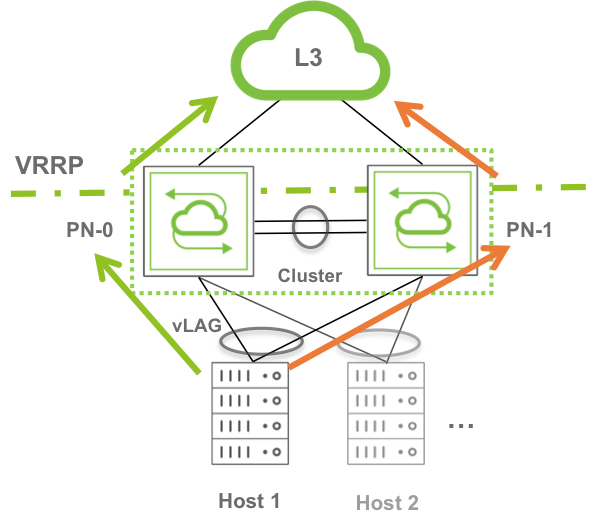
Understanding Virtual Router Redundancy Protocol (VRRP)
The Virtual Router Redundancy Protocol (VRRP) is a standard high-availability protocol initially defined by the Internet Engineering Task Force (IETF) in RFC 2338, later superseded by RFC 5798 for version 3 of the protocol with support for both IPv4 and IPv6.
The goal is to eliminate the single point of failure inherent in the first hop router (default gateway) for the connected hosts. Therefore, when at least two potential first hop routers are deployed, VRRP can be used to dynamically assign responsibility for the function of “virtual next hop” to either of the active routers on the (V)LAN. This is done by implementing an election protocol to select a so-called master router out of the two (or more) VRRP-capable routers available.
A master router performs the function of virtual router, i.e., controls the IPv4 or IPv6 address(es) (called virtual addresses or VIPs) used as default gateway(s) by the hosts and forwards packets sent to these address(es).
Non-elected router(s) are called backup router(s). The VRRP logic supports dynamic failover in the forwarding responsibility to a backup router, if the master router becomes unavailable.
- For IPv4, the critical benefit provided by VRRP is a higher-availability default gateway function with a resilient VIP address.
- For IPv6 configurations in which standard IPv6 Neighbor Discovery mechanisms could potentially help with the selection of the default gateway, the key benefit provided by VRRP is to provide a fast failover and a resilient VIP address.
VRRP supports rapid transition from master to backup router in case of node failure. The master router sends VRRP advertisements every second to the backup(s). If the master router’s advertisements are not received within a time window of three seconds, then a backup router is elected as the master. If the failed master router becomes active again, it can reclaim the role of master or allow the former backup to continue as the master router. The role depends on the value assigned to a parameter called VRRP priority.
VRRP routers are configured with a priority of between 1 and 254 and the router with the highest priority is elected to be the master. The default priority is 100.
At Layer 2 a VRRP virtual router must use an address in the 00-00-5E-00-01-XX Media Access Control (MAC) address range. In particular, the last byte of the address (XX) corresponds to the Virtual Router Identifier (VRID), which is distinct for each virtual router in the network. A VRRP virtual router will reply with this special MAC address when an ARP request is sent for the virtual router's IPv4 address.
As we will see in subsequent sections, having a resilient VIP that survives device failures is critical for simpler and more effective high availability of advanced services.
In Arista’s network designs VRRP can be used in conjunction with clusters and vLAG to combine fast switchover capabilities at Layer 2 with a redundant Layer 3 VIP for first hop routing toward the upstream part of the network (i.e., toward spine switches or other network devices).

Figure 7-7 - Example of Use of VRRP in Conjunction with a Cluster
In addition, Arista’s implementation optimizes the performance of this technology combination by supporting active-active Layer 3 forwarding on both VRRP routers in a cluster pair.
In other words, when a VIP is configured, each router is expected to route in hardware on behalf of the other peer for any packets destined to the VIP.
